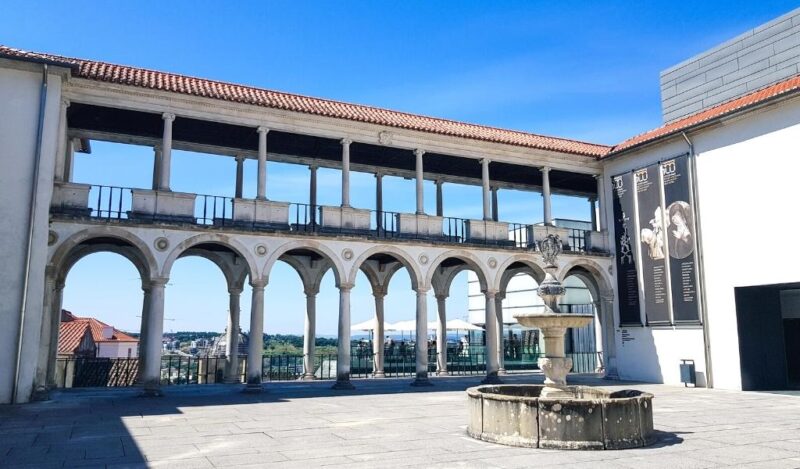Guimarães Castle or Castle of Saint Mammes (in Portuguese, Castelo de Guimarães or Castelo de São Mamede) is one of the most beautiful and most important castles in Portugal. Not to mention that it has been a National Monument since 1881, a UNESCO World Heritage Site since 2001, and one of the 7 Wonders of Portugal since 2007. Therefore, it’s only natural that this medieval castle is one of the most visited in the country!
Located in the city of Guimarães (in the Braga district), Guimarães Castle is linked to the foundation of Portugal, as a sovereign and independent nation. This is because its construction dates from the mid-10th century when the region belonged to the County of Portugal – although it has undergone remodeling over the centuries!
So, do you want to know more about Guimarães Castle: Best Tips For Visiting In 2024? Keep reading!
This post may contain affiliate links, meaning I earn a small commission if you make a purchase, at no additional cost to you. Please read my disclosure & privacy policy for more information.
No time to read now? Pin it for later!


Brief History of Guimarães Castle
Guimarães Castle was erected in the 950s, at the request of Countess Mumadona Dias, the most powerful and influential woman of her time in the County of Portugal and in the northwest of the Iberian Peninsula. However, as the structure was made of wood, few traces remain of this first fortress.
At the end of the 11th century, Count Henry of Burgundy and Countess Theresa of León (the parents of Afonso Henriques, the first king of Portugal) decided to completely renovate the primitive castle. From this time, the expansion of the walls and the creation of two access doors stand out.

Guimarães Castle was a key part of the Siege of Guimarães in 1127 – imposed by King Alfonso VII of León and Castile on the Infante Afonso Henriques – and of the Battle of São Mamede in 1128 – where Afonso Henriques fought against his mother, Theresa of León Both events were crucial to Portugal’s independence.
In the following reigns, Guimarães Castle continued to be expanded and reinforced. And, in the second half of the 13th century, it reached its current appearance, after the addition of eight Gothic turrets. But since then, it hasn’t recovered the protagonism it once had and ended up losing its military role between the 15th and 16th centuries.
World Heritage
Did you know that Guimarães Castle (and the Historic Center of Guimarães) was part of Portugal’s eighth set of inscriptions on the UNESCO World Heritage List? This 25th session of the World Heritage Committee took place in Helsinki (Finland), between December 11th and 16th, 2001.
Only one other Portuguese site was announced in the session: the Alto Douro Wine Region.
Nowadays, Portugal is the ninth country in Europe and the eighteenth country in the world with the most UNESCO sites, tied with Czechia and Poland. It has seventeen heritage assets (both cultural and natural) inscribed on the world list of the United Nations Educational, Scientific, and Cultural Organization.
In the meantime, I’ve already had the opportunity to visit fourteen of them:
- Alto Douro Wine Region (2001)
- Convent of Christ in Tomar (1983)
- Cultural Landscape of Sintra (1995) – Chalet of the Countess of Edla, Convent of the Capuchos, Moorish Castle, National Palace of Pena, National Palace of Sintra, Palace of Monserrate, Quinta da Regaleira, Villa Sassetti
- Garrison Border Town of Elvas and its Fortifications (2012)
- Historic Center of Évora (1986)
- Historic Center of Guimarães and Couros Zone (2001, 2023)
- Historic Center of Porto, Luiz I Bridge, and Monastery of Serra do Pilar (1996)
- Monastery of Alcobaça (1989)
- Monastery of Batalha (1983)
- Monastery of the Hieronymites and Tower of Belém in Lisbon (1983)
- Prehistoric Rock Art Sites in the Côa Valley (1998, 2010)
- Royal Building of Mafra – Palace, Basilica, Convent, Cerco Garden, and Hunting Park (Tapada) (2019)
- Sanctuary of Bom Jesus do Monte in Braga (2019)
- University of Coimbra – Alta and Sofia (2012)
How to Get to Guimarães Castle
Let’s suppose you want to visit Guimarães Castle on a day trip from Porto or on a road trip through the Braga district. In this case, you can take the opportunity to discover not only the city of Guimarães, but also other destinations in the surroundings: Vizela (13 km), Fafe (14 km), Póvoa de Lanhoso (20 km), Braga (26 km), Vila Nova de Famalicão (32 km), Vieira do Minho (34 km), and Celorico de Basto (37 km).
In my opinion, the fastest and most practical way to get to Guimarães Castle is by car. Nonetheless, if you don’t have that possibility, you can travel by train on the Guimarães Line. And for that, you only need to take the suburban train at the Porto-São Bento or Porto-Campanhã stations and get off at Guimarães (1.8 km on foot).
TIP: This trip has a minimum cost of €3.25, but check all prices, timetables, lines, and services on the official website of CP – Comboios de Portugal.
Opening Hours & Ticket Prices
Guimarães Castle is open every day, from 10 am to 6 pm, with the closing of the ticket office and the last entry taking place at 5:30 pm. The only days of the year when the monument is closed are the holidays of January 1st, Easter Sunday, May 1st, and December 25th.

Tickets cost 2€ (adults) or 1€ (holders of the Youth Card or Student Card, and seniors over 65 years old), and children up to 12 years old don’t pay admission. There are also combined tickets for €6 (Guimarães Castle + Palace of the Dukes of Braganza) or €8 (Guimarães Castle + Palace of the Dukes of Braganza + Alberto Sampaio Museum).
TIP: Like the other monuments and museums managed by the Regional Directorate for Culture of the North, Guimarães Castle is free on Sundays until 2 pm, for all residents in Portugal!
What to See at Guimarães Castle
Main Gate
As I mentioned earlier, the Main Gate of Guimarães Castle (in Portuguese, Porta Principal) was designed at the end of the 11th century, by order of Count Henry of Burgundy and Countess Theresa of León, the then rulers of the County of Portugal.
Installed on the west wall of the fortress, the Main Gate is today flanked by two imposing Gothic towers. The same happens with the second access gate – the Traitor’s Gate – which integrates the east wall, on the opposite side.
Since the turrets were built between the end of the 13th century and the beginning of the 14th century, it’s not known for sure whether this work campaign was carried out in the reign of Afonso III (1248-1279), or in the reign of Dinis I ( 1279-1325).

Alcazaba

When Count Henry of Burgundy and Countess Theresa of León moved to Guimarães Castle, the Alcazaba (in Portuguese, Alcáçova) became their official residence. In reality, there are those who claim that King Afonso Henriques was born here!
Unfortunately, the Alcazaba is one of the elements of Guimarães Castle that has deteriorated the most with the passage of time. But the ruins are still visible on the northern wall, once you enter the fortress!
Among the remains, the exterior windows and two chimneys stand out. One of them was partially rebuilt between 1936 and 1940, as part of the requalification project developed by the Estado Novo, for the centenary commemorations of the Foundation of Portugal (in 1140) and the Restoration of Independence (in 1640).
Place-of-Arms
The Place-of-Arms of Guimarães Castle (in Portuguese, Praça de Armas) is quite tiny when compared to the places-of-arms of other medieval Portuguese castles, such as Saint George’s Castle (in Lisbon), the Castle of Santa Maria da Feira, the Moorish Castle (in Sintra), Monsaraz Castle, Óbidos Castle, Bragança Castle, Sabugal Castle, Tomar Castle, the Castle of Montemor-o-Velho, or Marvão Castle!
Dominated by the impressive Keep in the center, the Place-of-Arms of Guimarães Castle served as a place of concentration for the military garrison, in case of siege or assault on the fortress. In fact, that’s exactly what happened in the Siege of Guimarães in 1127, provoked by King Alfonso VII of León and Castile!

Allure

The Allure (in Portuguese, Adarve) is an open passage very characteristic of medieval castles, which circles the top of the walls and gives way to the various towers and battlements.
Also called Chemin de Ronde (in Portuguese, Caminho de Ronda), the Allure of Guimarães Castle allows you to go through the entire defensive perimeter and, of course, enjoy the panoramic views of the old town of Guimarães.
Interestingly, the walls of the Guimarães Castle have the geometric layout of a pentagon, as the southern section ends in a beak – unlike the northern section, which is straight. And the battlements are equally pentagonal and with a pointed cut.
If you search for aerial photographs of the monument, you’ll notice that its shape is reminiscent of a shield!
Keep
The Keep (in Portuguese, Torre de Menagem) is the main structure of Guimarães Castle, as well as any other medieval castle. With a quadrangular plan and about 27 meters high, it has very few openings to the outside and its only access door is at the Allure level, as was usual in the Middle Ages.


If you follow the small wooden bridge, which connects the west wall and the Keep, you can visit the three floors that make it up and the rooftop. From here, you have panoramic views over the historic center of Guimarães, especially of the Palace of the Dukes of Braganza and the Chapel of São Miguel do Castelo!
Share this blog post on your social media!
More Posts about Portugal
4 Best Monasteries In Portugal (That You Should Visit This Year)
5 Best Palaces In Sintra (That You Should Visit This Year)
1 Day In Penafiel: The Perfect Penafiel Itinerary
More Posts about Castles and Palaces
5 Best Palaces In Sintra (That You Should Visit This Year)
Biscainhos Museum: Best Tips For Visiting In 2024
5 Best Castles In Portugal (That You Should Visit This Year)
More Posts about World Heritage
Palace Of The Dukes Of Braganza: Best Tips For Visiting In 2024
World Heritage In Castile And León (2024)
Machado De Castro National Museum: Best Tips For Visiting In 2024
What Photography Gear Do I Use?
- Camera Body: Fujifilm X-T4 Mirrorless
- Camera Lens: Fujinon XF 18-55 mm F2.8-4 R LM OIS
- Tripod: Manfrotto Compact Action
- Small Tripod: Manfrotto PIXI Mini
- Smartphone Adaptor: Manfrotto PIXI Clamp
- Memory Card: SanDisk 128GB Extreme PRO SDXC








